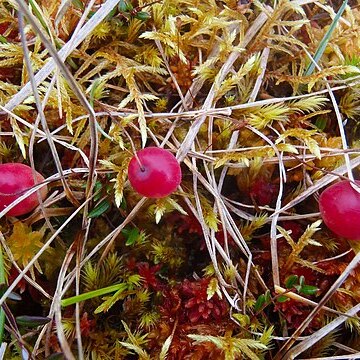Shrubs low, evergreen, 5–10 cm tall, ± procumbent, rhizomatous. Twigs terete, slender, puberulous, glabrescent; bud scales inconspicuous. Leaves quite dense; petiole less than 1 mm, puberulous; leaf blade ovate or elliptic, broader near base, 2–6 × 1–2(–3) mm, leathery, glabrous, secondary veins inconspicuous on both surfaces, base rounded, margin revolute, entire, without basal glands, apex acute. Flowers 1 or 2, terminal; bracts persistent, ovate, ca. 1 mm, glabrous. Pedicel recurved at apex, filiform, 1.5–2.5 cm, glabrous; bracteoles at middle. Flowers 4-merous. Hypanthium glabrous; calyx lobes suborbicular, ca. 0.5 mm. Corolla pinkish, glabrous, lobed nearly to base; lobes reflexed, oblong, ca. 5 mm. Filaments ca. 2 mm, glabrous; anthers ca. 2 mm; thecae without spurs, tubules ca. as long as thecae. Berry 4-loculed, red, ca. 6 mm in diam. Fl. Jun–Jul, fr. Jul–Aug. 2n = 24.
More
An evergreen shrub. It has thin creeping stems. It has slightly longer flower stalks than small cranberry (Vaccinium oxycoccus). The leaves are smaller and the fruit elongated. The leaves are very small and leathery. The edges roll under. The leaves are 3-7.5 mm long by 1-2.5 mm wide. They are dark green above and have a bluish bloom underneath. The flowers occur as 1-4 on the end of the stem. They are small and pink to red. The fruit are dark red berries. They are about 1 cm across. They are edible.

